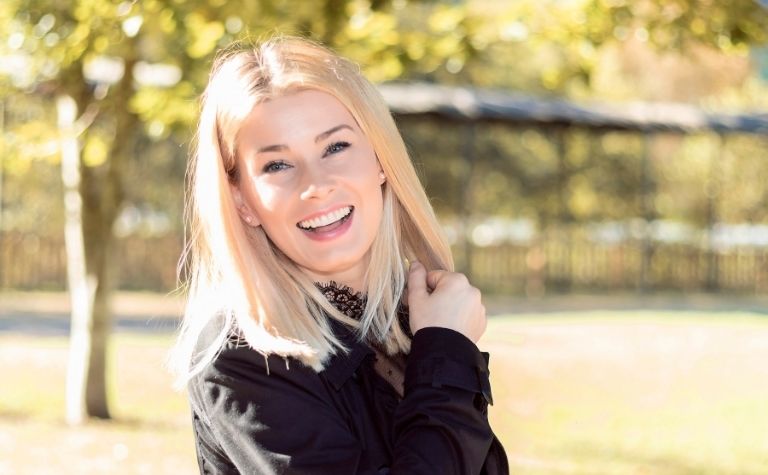The description of strong, blond-haired, blue-eyed Vikings traveling great distances and wreaking havoc and destruction wherever they went is common.
The reality is somewhat different according to DNA studies, which show that Vikings were not part of a single group and that the majority had brown hair.
54% of Swedes have blond hair, while 78% have blue eyes. The percentage of Swedes with blue eyes and blonde hair is only 32.2%.
The physical characteristics of Swedes have very little to do with the climate conditions they live under but rather with their ancestors’ living conditions.
Do Most Swedes Have Blonde Hair And Blue Eyes? Does Sweden Have The Most Blonde-Haired And Blue-Eyed People? Do Other Scandinavian Countries Have A Lot Of Blonde-Haired And Blue-Eyed People?
Keep reading to learn the answers to these questions and others.
Also see What Do Swedes Think of Americans? to learn more.

Do Most Swedes Have Blonde Hair And Blue Eyes?
Although blonde hair is the primary hair color of the Swedish population, the prevalence of people with blonde hair is not as significant as common stereotypes would have people believe.
The stereotypically tall, well-built, broad-shouldered Viking, with smoldering blue eyes and blonde hair, is the fiction of storytellers and Hollywood scriptwriters.
The reality is:
- Only half the population has blonde hair
- At an average height of 5 ft (180 cm), Swedes only rank in the top 16% of the world’s population
- The one truth that partially fits the stereotype is that 78% of Swedes have blue eyes
The Percentage Of Swedes Who Have Blonde Hair
The most widely accepted studies calculate that 54% of Swedes have pure blonde hair.
This percentage should be considered in context, as the definition of blonde hair may differ between research programs.
Some researchers insist that only pure blondes contribute to the blonde count, whereas in other studies, the term blonde includes those with “dirty blonde” hair.
The age and sex of the research participants also potentially skew the results of some studies.
- After puberty, girls have lighter hair than boys of the same age.
- With age, female blonde hair darkens more gradually than males.
The Percentage Of Swedes Who Have Blue Eyes
78% have blue eyes, and this characteristic, along with milky-white skin, are the two most dominant physical features of the Swedish population.
Also see Do Swedes Avoid Conflict? to learn more.

Does Sweden Have The Most Blonde-Haired And Blue-Eyed People?
Sweden does not have the highest number of blonde-haired and blue-eyed people:
- At 54%, the number of people with blonde hair ranks fourth in the Nordic countries.
- At 78%, people having blue eyes in Sweden rank second highest in the Nordic countries.
Interestingly the number of Swedish people who have both pure blonde hair and blue eyes is only 32.2%
Do Other Scandinavian Countries Have A Lot Of Blonde-Haired And Blue-Eyed People?
A 2019 study concluded the following hair color patterns for the Nordic region.
| Country | Pure Blonde Hair | Brown or Light Brown Hair | Red Hair |
| Sweden | 54.00% | 43.00% | 3.00% |
| Denmark | 64.00% | 30.66% | 5.34% |
| Finland | 58.00% | 40.00% | 2.00% |
| Iceland | 64.70% | 26.20% | 9.10% |
| Norway | 48.00% | 46.99% | 5.01% |
The percentage of people in the Nordic countries is as follows.
| Country | Blue Eyes Color | Brown Eye Color | Intermediate Eye Color |
| Sweden | 78.00% | 10.00% | 12.00% |
| Denmark | 64.84% | 14.71% | 20.45% |
| Finland | 89.00% | 11.00% | 10.00% |
| Iceland | 74.52% | 11.33% | 14.15% |
| Norway | 55.00% | 5.00% | 40.00% |
Also see Why Does Sweden Have So Many Metal Bands? to learn more.
What Influences Cause The Swedish Physical Characteristics?
A lot of research has been undertaken regarding why Swedes (and the broader Nordic populations) look the way they do.
The theory that Nords have adapted to lower levels of solar UV at higher latitudes is false for two reasons:
- The lack of UV is shared amongst all latitudes above 47 degrees, including Europe, Asia, and North America, yet only the Northern Europeans have milky white skin.
- Europeans became white-skinned over a relatively short timeframe of a few thousand years. The change would have begun much earlier if the skin melanin content had changed because of adaptation.
Scientists believe that there must have been other influences like latitudinal variation and sexual selection, which are discussed below.
Latitudinal Variation Required Men To Hunt
Early human groups were classified as either hunter-gatherers or simple farming people.
The difference in the way food was sourced varied by latitude. In the tropics, temperatures and rainfall patterns made crop farming viable, and women could grow food for the whole year.
Males were not required to undertake high-risk hunting activities, it was easier to provide for multiple families, and polygamy was practiced more frequently.
Males lived a much easier life with low mortality rates.
Below latitude of 40˚N, women supplied 40% – 55% of all food. Above 60˚N females provided less than 10% of all food.
Also see What Do Swedes Think of Norwegians? to learn more.

In The Higher Latitudes, Men Became The Hunters
The further a geographic area is away from the tropics, winters become harsher, and women become less able to farm during these periods.
In these areas, the males took on the hunter-gatherer role more often.
In the Northern latitudes, during the ice age, men were the primary hunters and the main source of food. The men hunted herds of herbivores (mainly reindeer) over very long distances and in challenging conditions.
They suffered high death rates due to the extreme distances they traveled to hunt, the number of accidents they suffered, exposure to the harsh elements, and starvation all served to increase their mortality rates.
The Nordic Countries Did Not Practice Polygamy
There was a low rate of polygamy in the Nordic region. Anthropologists have theorized that this was due to the harsh conditions.
The theory is that finding food and protecting the family from the weather and predators was very difficult. It was difficult for a man to provide food, shelter, and protection for one wife, let alone multiple wives.
For reasons that are unclear, the population groups within the Nordic region were dominated by double the number of women compared to men.
Generally speaking, men could choose their mate more selectively; thus, sexual selection became a key factor in defining physical traits.
One theory argues that when most females start to look similar, those with scarcer colors caught the attention of potential mates.
The theory postulates that there were fewer blonde-haired, blue-eyed females, and therefore they were more attractive to the males.
Also see Did Sweden Fight in World War II? to learn more.
Sexual Selection Is A Strong Determinant Of Characteristics
Theoretically, if there is an unequal balance of men and women, the sex with the smallest percentage has more choice and, as a result, will tend to enter a union with the member of the opposite sex, which is considered most attractive.
Research has shown that men place more importance on the physical characteristics of their potential mate than do women.
It is not the specific color (blonde, brunette, etc.) that is important, but rather the novelty factor. Women with hair color different from the average will be more attractive.
In one study, males were presented with slides showing attractive brunettes and blondes. The men rated the women by their perceived attractiveness:
- One series had equal numbers of brunettes and blondes.
- A second had 1 brunette for every 5 blondes.
- A third had 1 blonde for every 11 brunettes.
The result was that the rarer the hair color was in a series, the likelier they would choose the female with the rarer color.
Conclusion
Although the image of a stereotypical male is not accurate, there is a preponderance of Swedes who have either blonde hair or blue eyes.
The cause of this is due to an unbalanced count of males and females during the ice age; with the number of blonde, blue-eyed females being fewer in number, they were considered more appealing to some men.
Also see Do Swedes Hate Finns? to learn more.
